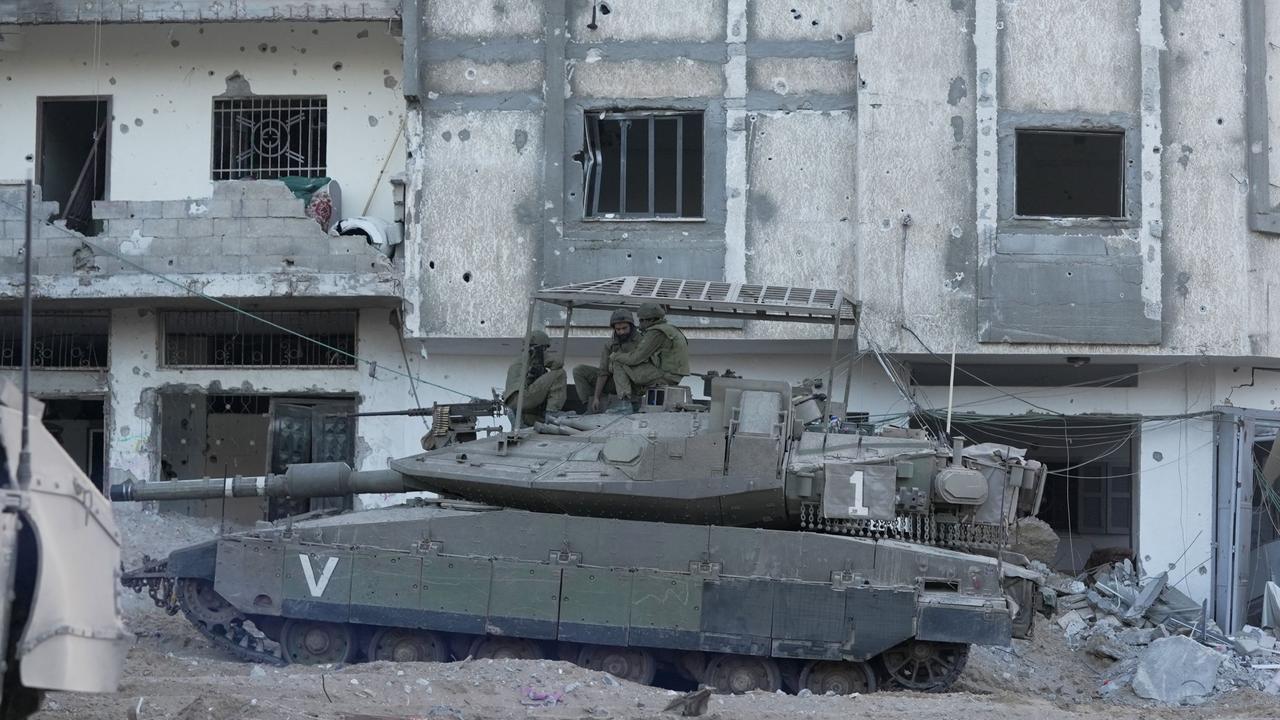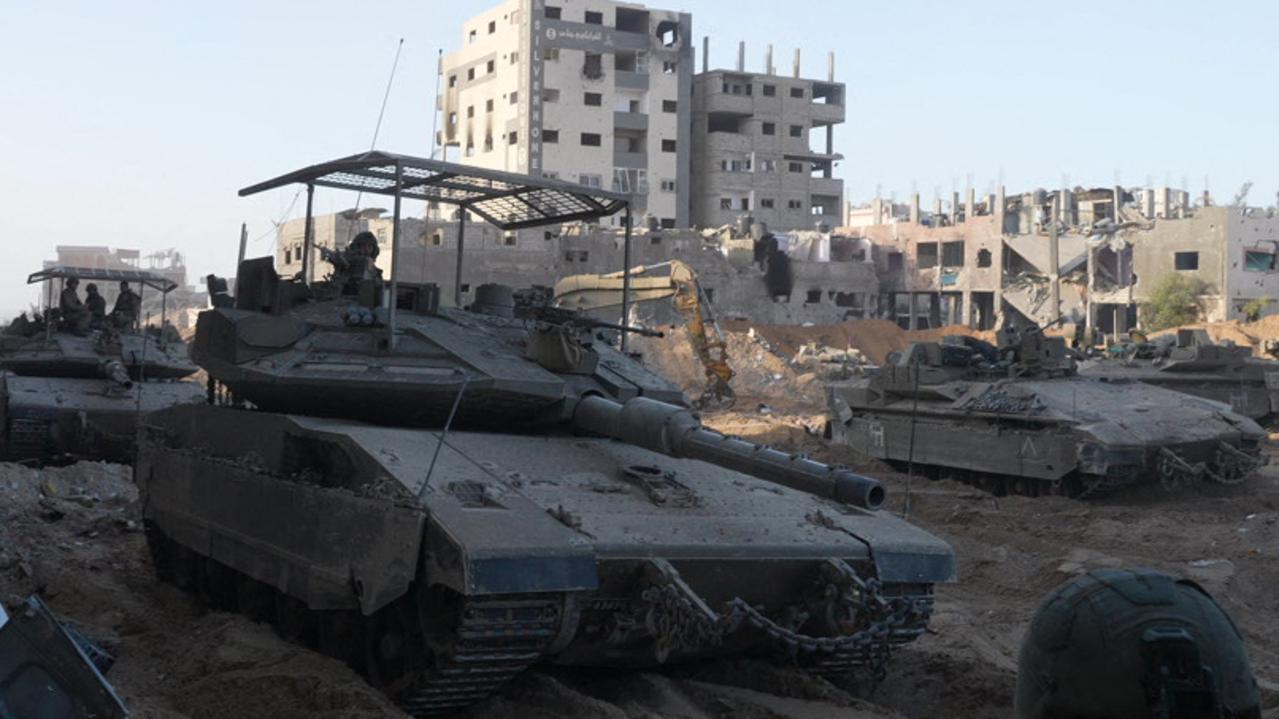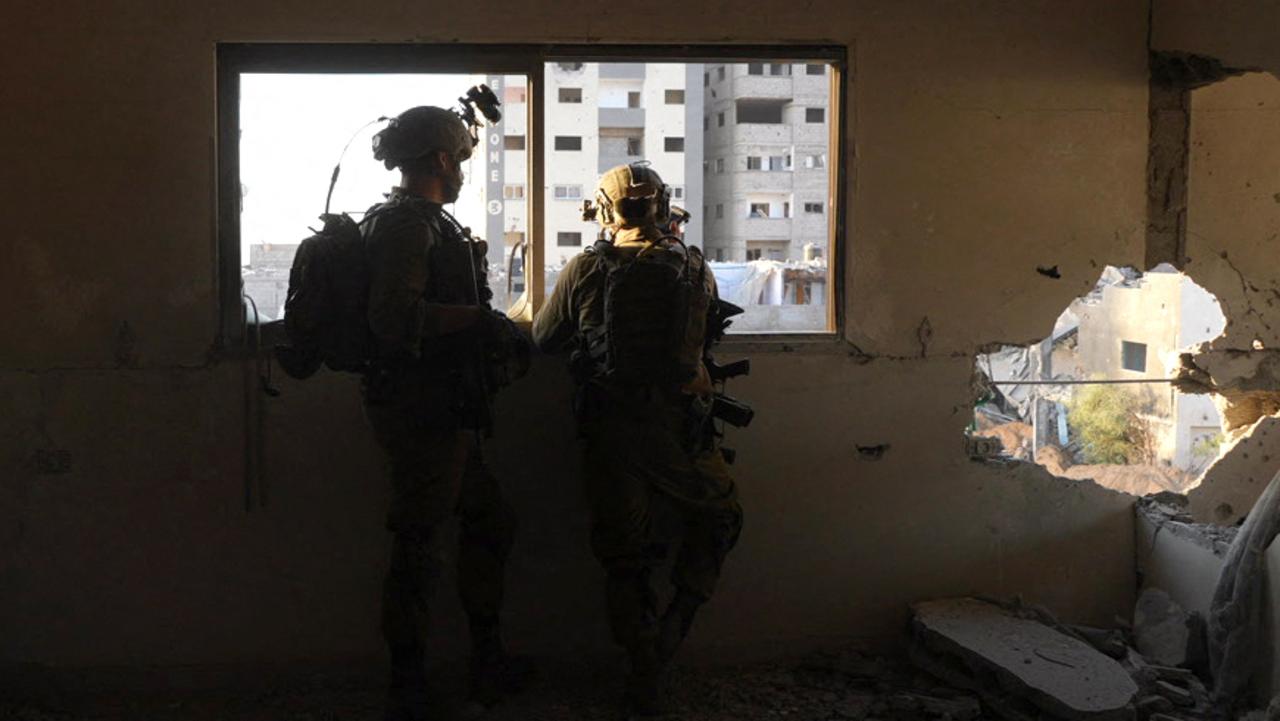Israel-Hamas war: Fierce street-by-street combat rages in Gaza City
Street-by-street combat is raging in the north of the Gaza Strip as Israel reckons with the nightmare of fighting in close quarters.

Israeli troops and Hamas were locked in heavy, close quarters fighting in Gaza City on Thursday, including a 10-hour battle that Israel said toppled one of the Palestinian militants’ “strongholds”.
Hamas fighters armed with rocket-propelled grenade launchers and assault rifles were clashing with Israeli soldiers backed by armoured vehicles in the ruins of the besieged territory’s north.
Broken palm trees, mangled road signs and twisted lampposts marked the remains of what was once north Gaza’s main arterial route, an AFP journalist saw, while embedded with Israeli troops on a controlled visit.
Israeli flags were flying over buildings at beach resorts in northern Gaza and there was little sign of any human presence amid the destruction, as hundreds of thousands have fled a dire humanitarian situation.
The utter devastation is the result of over a month of war sparked by the October 7 Hamas attacks on Israel.
On that day, gunmen from the Islamist group poured over the Gaza border with Israel and, according to Israeli officials, killed 1,400 people and seized about 240 hostages in the worst attack the country had ever suffered.
Vowing to destroy Hamas, Israel retaliated with an aerial bombing and ground offensive that the health ministry in the Hamas-run Gaza Strip claims has killed more than 10,800 people, many of them children.
Two more important medical centres, al-Rantisi Children’s Hospital and al-Nasr Hospital, have run out of fuel and shut down.


‘We don’t need you’: Israel’s fatal blunder
Britain’s Financial Times has published a new report on the intelligence failures that allowed Hamas to catch Israel entirely off guard on October 7.
It describes a patchwork of factors, significant among them a level of hubris from the IDF, which ignored warning signs.
For example: Israel had been relying on volunteers to monitor communications networks in Gaza and flag any important information. One such volunteer, Menachem Gida, told the FT he’d repeatedly warned the military that Hamas fighters were conducting war games near the Gazan border.
“You’re not important. We don’t need you,” an officer reportedly told him in response.
A former prime minister of Israel, Ehud Olmert, said his country had fallen prey to “overconfidence, which led to arrogance, which led to complacency”, and had enabled Hamas to “surprise” the IDF.
And an unnamed senior Israeli official told the paper there had been a “fundamental flaw” in the nation’s intelligence gathering.
“Even on the night of the attack, we smelled that something was happening, but the interpretation was that it was just a regular (Hamas) military exercise,” the official said.
Hamas stronghold falls
The Israeli military says its forces have captured a Hamas “military stronghold” in the western Jabalia area in the past day, adding that its troops “finished securing the compound after 10 hours of combat”.
The battle raged above and below ground, it said, exposing some of Hamas’s extensive network of tunnels and subterranean bases, which form a significant element of the militants’ capacity to fight.
Israel said dozens of militants were killed, and reported the overall death toll among its own troops in the ground offensive had risen to 34.
The intense combat, coupled with the desely populated coastal territory effective being sealed off, have led to increasingly dire conditions for civilians.
French President Emmanuel Macron urged nations to “work towards a ceasefire” between Israel and Hamas in Gaza, as he opened a conference on aid to the Palestinian territory in Paris.
Israel won’t attend the meeting, which aims to mobilise the main players involved in the humanitarian response in the Gaza Strip.
Today the Secretary-General of NATO, Jens Stoltenberg, said its members supported a humanitarian pause.
Tom Potokar, chief surgeon at the International Committee of the Red Cross, described the scene at the European hospital in Khan Yunis in southern Gaza as “catastrophic”.
“In the last 24 hours, I’ve seen three patients with maggots in their wounds,” Dr Potokar said.
A rare delivery of emergency medical supplies reached Gaza City’s main Al-Shifa hospital on Wednesday – just the second such delivery since the war began, the UN and World Health Organisation said, warning it was “far from sufficient to respond to the immense needs”.

Thousands flee the fighting
The Israeli army said 50,000 people had fled their homes in the main battle zone of northern Gaza on Wednesday, a sharp increase in numbers from earlier this week, adding to the more than 1.5 million people already seeking safety in the south of the coastal strip.
The UN Office for the Coordination of Humanitarian Affairs (OCHA), which is responsible for helping Palestinian refugees, confirmed the figure, and warned conditions were desperate in battle zones north of the central Wadi Gaza district.
“Hundreds of thousands of people remaining north of Wadi Gaza, including internally displaced people, are facing a dire humanitarian situation and are struggling to secure the minimum amounts of water and food to survive.”
UN rights chief Volker Turk condemned Israel over its bombardment and its orders for to Gazans to flee.
“The collective punishment by Israel of Palestinian civilians amounts also to a war crime, as does the unlawful forcible evacuation of civilians,” he told reporters at the Rafah border crossing with Egypt, the only route out of Gaza not controlled by Israel.
An Israeli military official insisted the Gaza Strip was not in a humanitarian crisis, even as he acknowledged the Palestinian territory faces several challenges amid the ongoing war.
“We know the civil situation in the Gaza Strip is not an easy one,” said Colonel Moshe Tetro, head of co-ordination and liaison at COGAT, the Israeli defence ministry body handling civil affairs in Gaza.
Efforts were underway to resume the crossing into Egypt of wounded Palestinians and dual nationals after departures were stalled on Wednesday, with Hamas blaming Israel for a failure to approve the list of injured to leave.
More than 100 trucks carrying aid crossed into Gaza from Egypt on Wednesday, OCHA said, taking the total to 756 since fighting began last month. That is fewer than the number that would normally have entered Gaza in just two days before the war.
“The aid getting through is a trickle,” Turk said.

After the war
Israeli Prime Minister Benjamin Netanyahu has repeatedly rejected a ceasefire unless the 239 hostages Hamas currently holds in Gaza are released.
According to a source close to Hamas, talks are underway for the release of 12 hostages, including six Americans, in return for a three-day ceasefire.
The United States has backed Israel’s rejection of a ceasefire, and G7 foreign ministers in Japan said on Wednesday they supported “humanitarian pauses and corridors”.
As the war intensifies, discussions on the possible future of Gaza once the conflict ends have also grown, after Mr Netanyahu this week said that Israel would assume “overall security” of the territory.
US National Security Council spokesman John Kirby said on Wednesday it was plausible that, “for at least some period of time”, Israeli forces would remain in Gaza “to manage the immediate aftermath and security situation”.
Israel seized Gaza in the 1967 Six-Day War and withdrew in 2005. Two years later, Hamas took control and Israel imposed a crippling blockade.
In the longer term, US Secretary of State Antony Blinken has suggested the Palestinian Authority, which exercises limited autonomy only in parts of the occupied West Bank, should retake control of Gaza.
“It must include Palestinian-led governance and Gaza unified with the West Bank under the Palestinian Authority,” Mr Blinken said on Wednesday, repeating the longstanding US call for a two-state solution.
Since the war broke out, violence has also gripped the West Bank, whose health ministry said eight Palestinians were killed during an Israeli army raid on the northern city of Jenin on Thursday.
Israel has confirmed its forces were operating in Jenin, but has not provided further detail.



